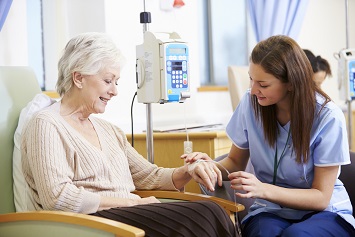Female nurses who give cancer patients their medications don’t always wear gloves or gowns to protect themselves from hazardous drugs, according to a new National Institute for Occupational Safety and Health (NIOSH) study.
When nurses administer chemotherapy in pill or liquid form (in an intravenous drip, for example) to patients diagnosed with cancer, the nurses are exposed to hazardous drugs known as antineoplastic drugs.
While these drugs are vital for cancer patients—the drugs kill rapidly dividing cancer cells—the drugs also can threaten a nurse’s healthy cells, as well as the cells of a developing baby.
Hazardous Drug List
NIOSH maintains a list of hazardous drugs. The institute most recently updated its list in 2016.
The effects of these hazardous drugs include:
- Carcinogenicity (actually causing cancer in otherwise healthy cells);
- Cytoxicity (literally toxic to cells);
- Fertility impairment or reproductive toxicity;
- Genotoxicity (causing mutations);
- Organ toxicity; and
- Teratogenicity (causing mutations in embryos or fetuses).
The NIOSH study found that nurses—including those who were pregnant—reported not wearing protective gloves and gowns, the minimum protective equipment recommended when administering these drugs.
Researchers from NIOSH and the Harvard T.H. Chan School of Public Health, Harvard Medical School, and Brigham and Women’s Hospital in Boston, Massachusetts, collected survey data from some 40,000 American and Canadian nurses participating in the Nurses’ Health Study 3.
In their study of nonpregnant and pregnant nurses, researchers learned that:
- Twelve percent of nonpregnant nurses and 9% of pregnant nurses indicated that they never wore gloves when administering antineoplastic drugs;
- Forty-two percent of nonpregnant nurses and 38% of pregnant nurses reported never using a gown;
- About 1 in 10 nurses, during their first 20 weeks of pregnancy, didn’t always wear gloves, and 1 in 2 didn’t always wear a protective gown when administering hazardous drugs.
Earlier this month, an American Society of Clinical Oncology (ASCO) panel that’s developing industry standards for handling hazardous drugs recommended limiting exposures for workers who are pregnant, breastfeeding, or trying to conceive by offering alternative work duties. The expert panel said that employees and employers share responsibility for reviewing and choosing alternative work arrangements.
Researchers in the NIOSH study could only speculate about the reasons that so many nurses did not use proper personal protective equipment (PPE) when administering hazardous drugs.
Earlier studies have revealed a variety of reasons for lack of safety precautions, including the following:
- Nurses sometimes prioritized care for patients over their own personal health;
- Nurses or their employers exhibited a lack of concern about or awareness of the toxicity of these drugs; or
- Protective gloves and gowns were not available or nurses were not given the opportunity to put on PPE.
The NIOSH study was published online by the American Journal of Nursing.
Employer and Employee Precautions
Healthcare employers must meet a number of requirements under the General Duty Clause of the Occupational Safety and Health Act, OSHA’s hazard communication standard, as well as several industry standards. These requirements include:
- Ensuring nurses and other healthcare workers (HCWs) are informed about the health hazards of antineoplastic drugs;
- Providing gloves, gowns, and other PPE, such as respirators, if necessary;
- Properly training HCWs in PPE use and performing respirator fit testing if respirators are used;
- Providing the space and opportunity to don and remove gloves, gowns, and other PPE; and
- Providing waste receptacles for used PPE and properly disposing of waste that may have become contaminated with either hazardous drugs or infectious materials.

